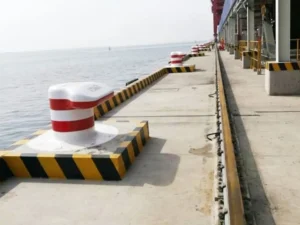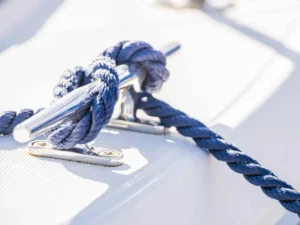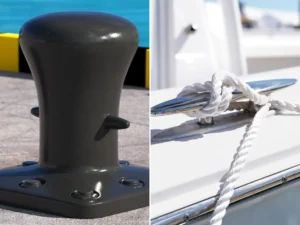Введение
Швартовка и доки имеют решающее значение для хранения, погрузки, разгрузки и безопасности лодок. Это означает, что вы не можете использовать любительские решения, которые ставят под угрозу безопасность ваших лодок и приводят к повреждениям в процессе погрузки. Итак, Какие у вас есть варианты в этом случае? Обычно, кнехты и лодочные колышки это два способа закрепить ваши суда. Оба инструмента обладают индивидуальной структурной целостностью и обеспечивают хорошую устойчивость во время швартовки. Но какой из них лучше?
Мы сравнили различные характеристики обоих инструментов, чтобы помочь вам определиться с выбором лучшего материала. Вы также узнаете об особенностях обоих материалов и их применении в морской промышленности.
Основы боллардов

Что такое болларды?
Вы могли видеть вертикальные столбы, если когда-нибудь посещали доки и набережные. Чаще всего это кнехты с прочной конструкцией и отличными стабилизирующими свойствами.
В сценариях швартовки и причаливания они являются решающим фактором. Кнехты помогают зафиксировать и предотвратить ненужные движения лодок.
Типы боллардов
Три основных типа боллардов основаны на их характеристиках и сценариях использования. К ним относятся:
-
Тумбы на столбах
Доски-столбы имеют длинный стержень со стойкой на голове. Они помогают перемещать большой вес и находят практическое применение в доках. Благодаря прочной конструкции их можно использовать в торговых портах.
-
Двухбитные болларды
Двухбитные кнехты имеют типичную Т-образную форму верха с двумя роговыми выступами. Он подходит для лодок и судов в качестве замка и ключа и пригоден для различных способов крепления. Благодаря своей уникальной форме, вы можете использовать его в различных областях для швартовки и причаливания судов.
-
Болларды с Т-образной головкой
Болларды с Т-образной головкой известны своей компактностью и простотой эксплуатации. Имея Т-образную форму, они отлично выдерживают перпендикулярные нагрузки и обеспечивают хорошую устойчивость.
Преимущества боллардов
Кнехты довольно эффективны для морской индустрии. Они обладают массой преимуществ, таких как:
-
Безопасная стыковка
Одна из главных задач кнехтов - фиксировать суда в одной точке при швартовке. Они предотвращают дрейф судов во время погрузки и разгрузки.
-
Предотвращение несчастных случаев
Неправильный контроль над лодками - это как приглашение опасности на порог вашего дома. Кнехты позволяют избежать подобных случаев, обеспечивая безопасную швартовку и предотвращая дрейф в оживленных портах. Таким образом, риск несчастных случаев сводится к нулю.
-
Стабильность и контроль
Если из-за сильного ветра ваше судно может зависнуть, используйте кнехты, чтобы держать ситуацию под контролем. Предельный контроль обеспечивает лучшую стабильность и эффективные результаты.
-
Структурная целостность
Болларды обладают высокой прочностью, что позволяет им входить в контакт с судами, не причиняя вреда. Вы можете рассчитывать на долгий срок службы и минимизацию расходов при их использовании.
-
Эстетика
Кнехты - это не просто элементы, выполняющие функцию крепления. Напротив, они привлекают внимание, особенно столбы и Т-образные кнехты, которые хорошо смотрятся внешне, поддерживая ваши лодки на причале.
Основы лодочной клипсы

Что такое лодочный клип?
Лодочный клип - это отличный материал, который крепится к лодкам и служит точкой опоры. Благодаря уникальным точкам крепления он приобретает устойчивость нового уровня. Кроме того, в них встроены противоскользящие элементы, обеспечивающие плавную фиксацию без незначительных движений.
Типы лодочных клюзов
Клипсы бывают разных форм и материалов. Поэтому мы разделили их на три основные категории. К ним относятся:
-
Палубные колышки
Палубные колышки часто бывают плоскими и служат отличными точками крепления для канатов и тросов. Благодаря универсальным креплениям они славятся безупречной фиксацией во время швартовки судна.
-
Роговые булавки
Рога позволяют лучше закрепиться. Закрепите канат вокруг рогов и наслаждайтесь лучшей устойчивостью. Обеспечьте хорошее сцепление и уверенно причаливайте к берегу без риска соскользнуть.
-
Зажимные планки.
Косяки подходят для временных парусных линий. Они оснащены механизмом захвата, позволяющим удерживать суда, и обеспечивают хорошую устойчивость.
Преимущества лодочного клина
Лодочные колышки обеспечивают хорошую устойчивость и обладают следующими преимуществами в морской индустрии.
-
Безопасная стыковка
Не обращайте внимания на сложные процессы докования. Надежно загружайте и разгружайте свои суда с помощью лодочных колышков. Они поставляются с креплениями для троса и каната, обеспечивая хорошую стыковку.
-
Эффективная стабильность
Поскольку колышки на судах оснащены дополнительными механизмами безопасности и противоскользящими элементами, они обеспечивают хорошую устойчивость. Вы можете безопасно загружать и разгружать свои лодки.
-
Простое управление
Обеспечьте быстрое и эффективное управление вашими лодками. Даже если на вас обрушились экстремальные погодные колебания, вы все равно получите стабилизированное крепление с помощью лодочного буксира.
-
Универсальный
Клинья для кораблей подходят для различных лодок, судов и кораблей. Вы можете использовать их даже для временных парусных процессов. Такая универсальность вам только на руку!
-
Меньше обслуживания
Вам не нужно регулярно проводить чистку и уход. Проводите еженедельные или ежемесячные осмотры. Проверяйте наличие царапин. Вовремя устраняйте все неполадки, чтобы избежать неприятностей в будущем.
Разница между кнехтами и лодочными клипсами

У кнехтов и лодочных буксиров есть различия в конструкции, функциях и устойчивости во время работы. Давайте обсудим каждое из этих различий.
| Характеристики | Болларды | Клипсы | Победитель |
| Конструкция и крепление | Вертикальный и обеспечивает надежное крепление | Горизонтальные и обеспечивают менее мощное крепление | Боллард |
| Несущая способность | Высокая производительность | Меньшая вместимость | Боллард |
| Портативность | Неподвижные и непригодные для транспортировки | Легко транспортировать | Клинья |
| Простота в обращении | Осторожное обращение | Простой в обращении | Клинья |
Конструкция и навесное оборудование
Дизайн - это первое, на чем останавливается взгляд. Анкерные материалы чаще всего бывают вертикальными и горизонтальными. Некоторые из них имеют различную форму и дизайн. Давайте узнаем об этом здесь.
Кнехты - это вертикальные материалы, которые крепятся к берегам и точкам крепления на причале. Они довольно прочны, изготовлены из твердых и ударопрочных материалов и обеспечивают хорошую устойчивость в работе. Кроме того, вы можете изменить их форму - от столба до Т-образного кнехта.
Лодка-шпилька несколько отличается от кнехтов, но выполняет те же функции. Он имеет горизонтальную форму и менее прочен по сравнению с кнехтом, но оснащен функцией защиты от скольжения. Кроме того, такие материалы крепятся к кораблям и судам, в отличие от кнехтов, которые крепятся к креплениям дока. Кнехты бывают разных типов, например, палубные, рогатые или шлямбурные.
Несущая способность
Это зависит от типа груза и разновидности судна. Например, у вас есть большое судно весом 1000 тонн. По сравнению с ним малое судно выдерживает меньший вес. Клинья на судах также определяют, совместимы они или нет.
Болларды довольно надежны и прочны. Их конструкция и дизайн позволяют выдерживать тяжелые транспортные средства. Если в порту собираются пришвартоваться большие суда, установите на площадке кнехты, так как они выдержат весь вес и обеспечат хорошую устойчивость.
Прежде всего, лодочный колышек обладает меньшей несущей способностью. Вы не сможете установить более гигантские лодки и ожидать от них такой же эффективности, как от кнехтов. Поэтому при использовании тесемок подумайте о том, что для швартовки и причаливания подойдет лодка поменьше.
Портативность
Вы хотите транспортировать болларды и защелки? Иногда необходимо достичь высокого уровня гибкости для подходящих погрузочно-разгрузочных работ. Сообщите нам, какой материал обеспечивает наилучшую мобильность.
Чаще всего кнехты крепятся к месту стыковки. Их реже перемещают, они имеют фиксированную конструкцию, что сводит к минимуму их универсальность. Кроме того, они непригодны для транспортировки из-за большого веса и прочной конструкции.
В отличие от них, булавки хороши с точки зрения портативности и универсальности. Их можно менять в зависимости от типа лодки, необходимости и требований к материалам. Кроме того, они легко транспортируются в отдаленные места, не создавая особых проблем для пользователей.
Простота в использовании и обращении
Если вы профессионал и готовы работать с анкерными материалами, это замечательно! А если вы не являетесь экспертом? В этом случае вам нужно подумать о процессах обработки.
Болларды представляют большую опасность для членов экипажа и требуют осторожного обращения. Если вы ищете, как их обслуживать, то они прочны и имеют долгий срок службы. Сложности возникают во время стыковки. Обращайтесь с ними очень осторожно и ожидайте наилучших результатов.
С другой стороны, колышки довольно просты в обращении, универсальны и требуют меньшего опыта. Вы должны использовать качественные тросы и выполнять стыковку без риска для безопасности членов экипажа.
Что лучше: кнехт или лодочный клип?
Обычно она зависит от различных факторов, таких как:
- Тип вашей лодки: большая или маленькая?
- Нагрузка на судно: высокая или низкая?
- Вам нужна универсальность и мобильность.
- Как насчет долгого срока службы и обслуживания?
Исходя из этих факторов, вы можете выбрать лучший стыковочный материал. Например, не стоит ожидать высоких эксплуатационных характеристик от больших лодок с высокой нагрузкой. То же самое можно сказать о долговечности и портативности. Исходя из ваших предпочтений, вы можете выбрать лучший материал.
Заключение
Клинья на кораблях впечатляют своим креплением и стыковкой. Но вы не можете игнорировать заклинания кнехтов, поскольку они весьма примечательны в своей работе. Как правило, необходимо учитывать все факторы и искать лучший материал. Выбирая лодочные швартовы или кнехты, отдавайте предпочтение материалам высшего качества и высочайшей производительности.
Джерри Борг Марин является одним из лучших поставщиков боллардов. У нас вы найдете болларды премиум-качества по доступным ценам. Проверьте различные материалы и выберите лучший. Получите его прямо сейчас!
